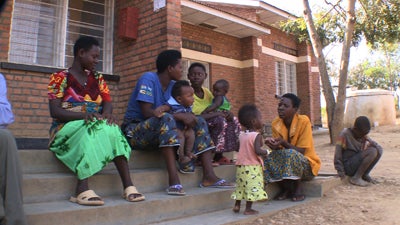Adventure Film 101: The Value of Filmmaking Mistakes

Women at a medical clinic in Rwanda – part of the millennium villages project (Michael Brown)
Hello from Rwanda.
I’m here with Dr. Geoff Tabin, co-director of the Himalayan Cataract Project, who is performing surgeries to restore eyesight to people with cataracts.
Just 15 years ago over 800,000 people were murdered here in a tragic mass genocide. Today there are ten million people on a piece of land the size of Massachusetts. Most of them are very poor and, like many parts of Africa, the real jobs are in either government of foreign aid work.
Tourism is regaining a foothold and the country’s gorillas are one of its best assets. There is another great potential in the country that has yet to be realized: the people are warm and inviting with a resourceful spirit.
A gorilla in Rwanda. (Michael Brown)
In addition to Tabin, I’m also here with photographer Ace Kvale and author David Relin (“Three Cups of Tea”).
The goal is to study the economic effects of blindness and the affect of restoring eyesight. For every person who is blind, there is also a caregiver who has to devote at least a part of his or her time to the blind person. By restoring eyesight when it is possible the hope is both help the individual by removing the cataract and to add to the economic potential.
My role here has been to shoot the film portion of he coverage, with the goal of creating a documentary to continue getting the word out about these programs. David is writing a book about Geoff’s work and Ace is capturing his usual stunning still images. We all know that is a valuable and important story to tell and even if the work is on spec if should bring a return some day soon.
Geoff Tabin performs a cataract surgery. (Michael Brown)
I shoot on location 99 percent of the time and there are inherent challenges that go with it.
Just yesterday I was shooting and suddenly realized that a setting was wrong on the camera. I had the gain set too high and the images would have an undesirable graininess to them. Sometimes on a production, we can really blow it and shoot a lot of material that isn’t any good.
Ace, who has shot for a slew of huge publications, saw my frustration and said something that really helped: “You have to just keep going, do your best and hope that you get something good.”
He was so right. It is all we can do. I was bummed that some material wouldn’t look as good as it could but the bulk of the rest would be great.
The lesson is that you need to always do your best, don’t let your mistakes cripple your efforts, and keep going. Sounds simple, but there it is.
One of my students asked m once: “How often does the finished product change from what you initially thought it would be?”
“Always,” I said. And that’s the truth. You just have to keep shooting and use your instincts to capture those moments you feel are the most poignant.
So often the best material for a shoot comes unexpectedly on the last day of production. It is like all the time you spend is just getting you ready for that critical moment.
Our mistakes are our best learning experiences and speaking of them, there’s a new program out there that Apple’s develop called Challenge Based Learning that emphasizes this process.
Our team from BLINDSIGHT (the film we shot in 2006 about six Tibetian teenagers’ attempt to climb 23,000-foot Lhakpa in Nepal), have gotten involved, along with Jamie Hyneman and Adam Savage, the hosts of “MythBusters.”
They are setting up a program that allows students to make mistakes and learn from them. Most current high school curriculums in this nation don’t not allow for mistakes and are actually quite harsh toward experimentation and creativity.
The take home? We need to make mistakes to learn. So, get that camera out and let it be overexposed and out of focus on that critical shot. Next time you’ll double check.
Was in Africa for a month and as much as I had planned to write up a storm, no way. This week I moved, next should be okay again.
–MICHAEL BROWN
For more filmmaking advice from Michael Brown, check out the Adventure Film 101 Archive.
PLUS: Get Michael’s essential tips on shooting in any condition and see his tips on filming your own adventure. For more, go to www.seracfilms.com .